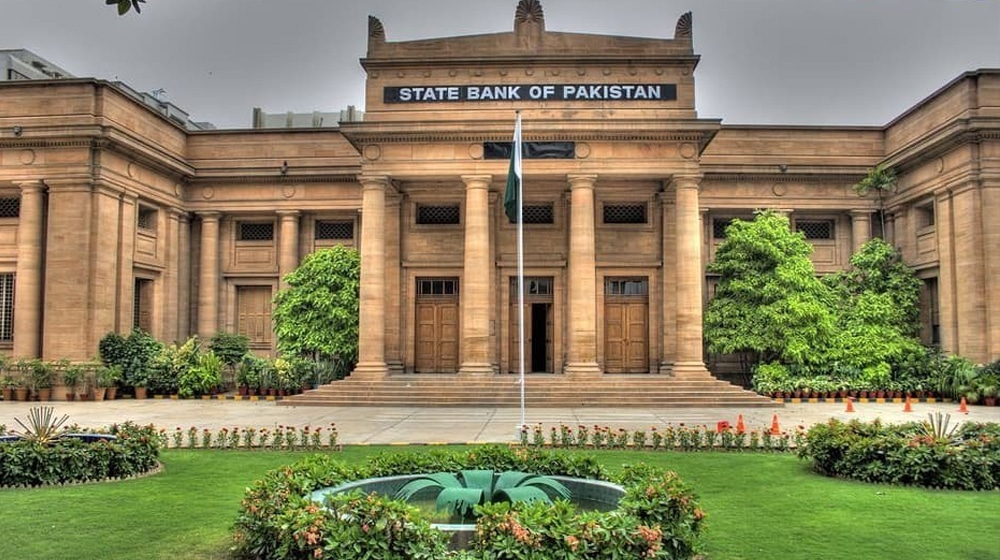The State Bank of Pakistan’s (SBP) Monetary Policy Committee (MPC) on Monday decided to keep the policy rate unchanged at 15 percent.
According to a statement issued by the bank, “At today’s meeting, the Monetary Policy Committee decided to maintain the policy rate at 15 percent”.
“With recent inflation developments in line with expectations, domestic demand beginning to moderate & the external position showing some improvement due to a lower trade deficit and resumption of the IMF program, the MPC felt that it was prudent to take a pause at this stage,” it added.
1/5 At today’s meeting, the Monetary Policy Committee decided to maintain the policy rate at 15 percent. See https://t.co/rzvfGJyCqe
— SBP (@StateBank_Pak) August 22, 2022
It said, “This pause allows MPC to assess impact of 800bps tightening since Sept & fiscal consolidation planned for FY23. It is also in line with recent actions by other EM central banks, who have been holding rates in recent meetings as global growth & commodity prices have slowed”.
“To contain external pressures and support the Rupee going forward, it is important to contain the current account deficit by delivering the budgeted fiscal consolidation, lowering energy imports through energy conservation measures, and keeping the IMF program on-track,” it added.
The Bank further mentioned, “Looking ahead, the MPC intends to remain data-dependent, paying close attention to month-on-month inflation, inflation expectations, developments on the fiscal and external fronts, as well as global commodity prices & interest rate decisions by major central banks”.
The Pakistan Business Council lauded the central bank’s decision to keep the policy rate unchanged. It tweeted, “We welcome the @StateBank_Pak MPC’s decision not to increase the policy rate further. Significant demand and import compression (including targeted non-rate) measures are already in place. Industry is working well below capacity due to import curbs. Recession is a risk”.
We welcome the @StateBank_Pak MPC’s decision not to increase the policy rate further. Significant demand and import compression (including targeted non-rate) measures are already in place. Industry is working well below capacity due to import curbs. Recession is a risk.
— The Pakistan Business Council (@ThePBC_Official) August 22, 2022
Since the last meeting, the MPC noted three key domestic developments. First, headline inflation rose further to 24.9 percent in July, with core inflation also ticking up. This was expected given the necessary reversal of the energy subsidy package—effects of which will continue to manifest in inflation out-turns throughout the rest of the fiscal year—as well as momentum in the prices of essential food items and exchange rate weakness last month.
Second, the trade balance fell sharply in July and the Rupee reversed course during August, appreciating by around 10 percent on improved fundamentals and sentiment.
Third, the Board meeting on the ongoing review under the IMF program will take place on August 29th and is expected to release a further tranche of $1.2 billion, as well as catalyze financing from multilateral and bilateral lenders.
In addition, Pakistan has also successfully secured an additional $4 billion from friendly countries over and above its external financing needs in FY23. As a result, FX reserves will be further augmented through the course of the year, helping to reduce external vulnerability.
In terms of international developments, the MPC noted that both global commodity prices and the US dollar have fallen in recent weeks, in response to signs of a sharper than anticipated slowdown in global growth and nascent market expectations that the US Federal Reserve tightening cycle may be less aggressive than previously anticipated. In contrast to the trend since last summer, more emerging market central banks have started to hold policy rates in their recent meetings.
This suggests that globally, risks may be shifting slightly from inflation toward growth, although this remains highly uncertain at this stage.
On balance, the MPC noted that some greater slowdown in global growth would not be as harmful to Pakistan as for most other emerging economies, given the relatively small share of exports and foreign private inflows in the economy. As a result, both inflation and the current account deficit should fall as global commodity prices ease, while growth would not be as badly affected.
Real sector
As expected, economic activity has moderated since the last MPC. Most demand indicators have softened—sales of cement, POL, fertilizers and automobiles fell month-on-month in July—and year-on-year growth in LSM almost halved in June. Recent flooding caused by unusually heavy and prolonged monsoon rains creates downside risks for agricultural production, especially cotton and seasonal crops, and could weigh on growth this year.
Looking ahead, the MPC continues to expect growth to moderate to 3-4 percent in FY23, on account of the tightening of fiscal and monetary policies.
This will ease demand-side pressures on inflation and the current account and lay the ground for higher growth in the future on a more sustainable basis.
For higher and more sustainable growth over the medium-term, structural reforms to decisively move Pakistan’s growth model away from consumption toward exports and investment are also urgently needed.
External Sector
After widening significantly in June, the trade deficit halved to $2.7 billion last month, as energy imports declined significantly and non-energy imports continued to moderate. According to PBS data, imports fell sharply by 36.6 percent (m/m) and 10.4 percent (y/y). Exports also declined by 22.7 percent (m/m), largely due to the Eid holidays but also on some emerging signs of slower global demand. Meanwhile, remittances remained strong.
As a result of these better current account developments and improved sentiment due to diminished uncertainty about the IMF program, the Rupee recovered in August. In addition to slower domestic demand, the recent decline in imports also reflects temporary administrative measures, including the requirement of prior approval before importing machinery and CKDs of automobiles and mobile phones.
These administrative measures are not sustainable and will need to be eased in the coming months. In order to ensure that the overall import bill remains contained as these measures are eased, it will be critical that the envisaged fiscal consolidation in FY23 is delivered and that strong measures are taken to curtail energy imports. Such measures include early closure of markets, reduced electricity use by residential and commercial customers, and greater encouragement of work from home and carpooling.
Notwithstanding the recent improvement in the current account and the Rupee and FX reserves have halved from $16.4 billion in February to $7.9 billion on August 12th, as official inflows have been outpaced by official outflows. The drying up of official inflows—namely multilateral, bilateral, and commercial borrowing as well as Eurobond and Sukuk issuance—was in large part due to the delay in completing the review of the IMF program because of policy slippages. Meanwhile, on the outflows side, debt servicing on foreign borrowing continued as repayments came due.
However, with the expected completion of the upcoming IMF review and the additional assistance secured from friendly countries, FX reserves are projected to rise to around $16 billion during FY23. To ensure this and to support the Rupee going forward, it will be important to contain the current account deficit to around 3 percent of GDP by moderating domestic demand and energy imports. In addition, it will be critical to keep the IMF program on track by following through on the agreed fiscal tightening and structural reforms over the next 12 months.
Fiscal sector
For the first time in seven years, the FY23 budget targets a primary surplus, on the back of significantly higher tax revenue. It envisages a strong fiscal consolidation of around 3 percent of GDP, which is appropriate to cool the economy and ensure a reduction in inflation and the current account deficit throughout the year.






















